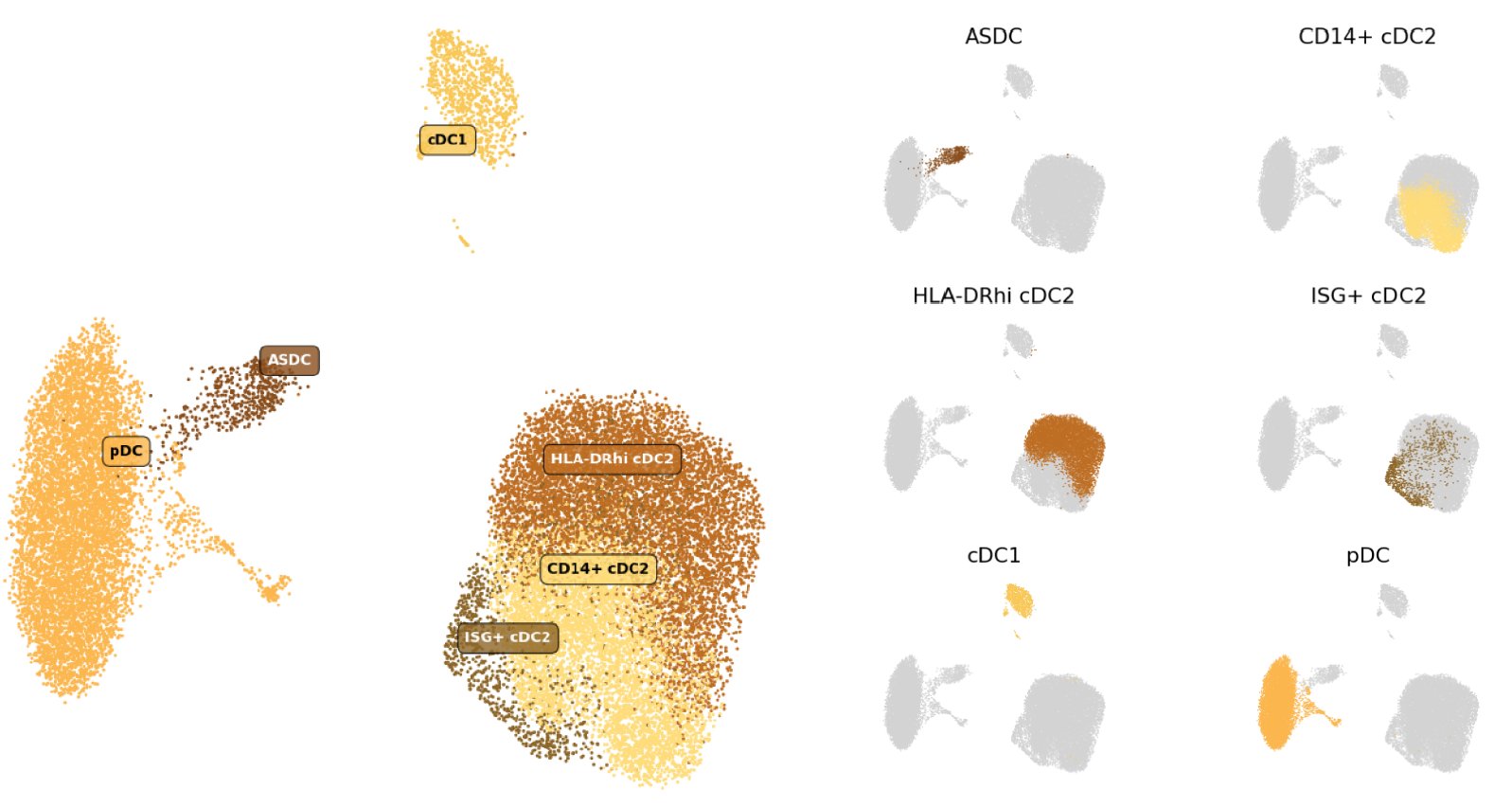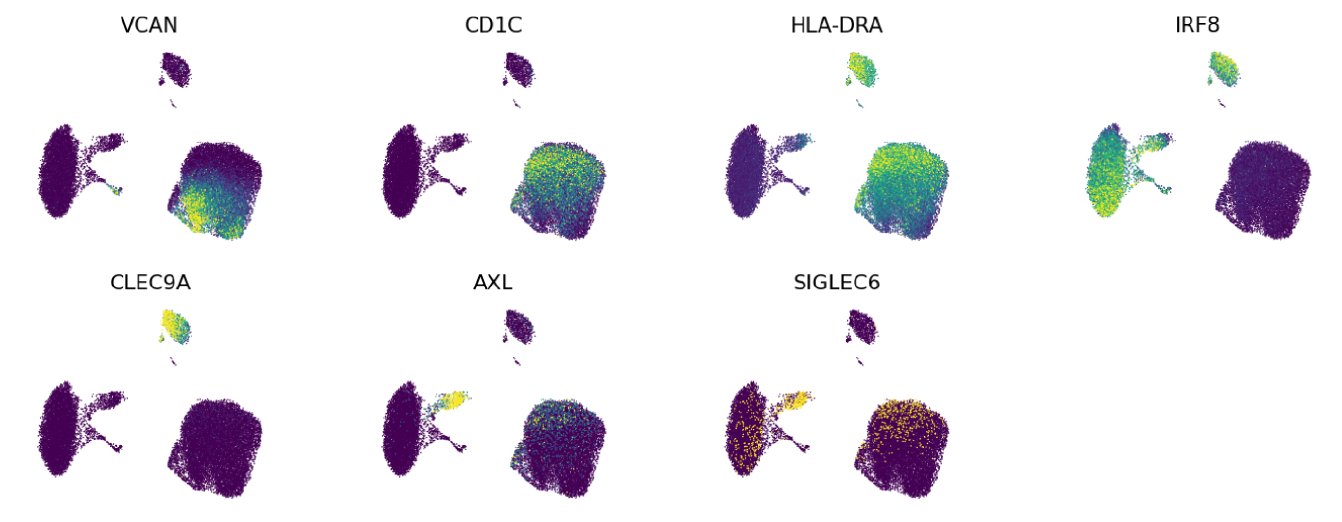
In our cell type atlas, we define Dendritic cell (DC) types at 3 levels of resolution, from one Level 1 type (broadest) to 6 Level 3 types (highest resolution) based on marker gene expression and cell types previously described in literature. Descriptions of the marker expression criteria are provided below.
The hierarchical relationships between types, the usage of labels at each level of our cell type hierarchy, and the number and proportion of cells relative to parent populations and the full dataset (All) are shown here:
| Cell Type | Level(s) | N cells | % of Parent | % of All |
|---|---|---|---|---|
| DC | 1 | 23,287 | NA | 1.28% |
| ├ ASDC | 2, 3 | 522 | 2.24% | 0.03% |
| ├ cDC1 | 2, 3 | 943 | 4.05% | 0.05% |
| ├ cDC2 | 2 | 14,235 | 61.13% | 0.78% |
| ┆ ├ CD14+ cDC2 | 3 | 5,646 | 39.66% | 0.31% |
| ┆ ├ HLA-DRhi cDC2 | 3 | 7,353 | 51.65% | 0.40% |
| ┆ └ ISG+ cDC2 | 3 | 1,236 | 8.68% | 0.07% |
| └ pDC | 2, 3 | 7,587 | 32.58% | 0.42% |
Cell type definitions
Level 1
In this reference we have one Level 1 label:
- DC: Dendritic cells (DCs) were identified by high expression of the cystatin C (CST3) gene, which is shared with monocytes, and the CD135 gene, fms related receptor tyrosine kinase 3 (FLT3), which is also expressed by some progenitor cell types, but has much lower expression in monocytes. Most DCs also express high levels of the major histocompatibility complex, class II genes HLA-DPA1, HLA-DRA, and CD74.
Level 2
At Level 2, we subdivided DCs into 4 major subclasses (Villani, et al. 2017):
- ASDC: AXL+ SIGLEC6+ dendritic cells (ASDCs) were identified as DCs that express a distinct transcriptome profile including genes for AXL receptor tyrosine kinase (AXL), the CD327 gene sialic acid binding Ig like lectin 6 (SIGLEC6), as well as hepcidin antimicrobial peptide (HAMP).
- cDC1: Conventional type 1 dendritic cells (cDC1) were identified as DCs with high expression of the CD370 gene C-type lectin domain containing 9A (CLEC9A), X-C motif chemokine receptor 1 (XCR1), indoleamine 2,3-dioxygenase 1 (IDO1), and the C1orf54 gene.
- cDC2: Conventional type 2 dendritic cells (cDC2) are the largest DC subset, and have high expression of the CD1c molecule gene (CD1C), and share expression of the ficolin 1 (FCN1) gene and paired immunoglobin like type 2 receptor alpha (PILRA) gene with monocyte cell types, but not other DC types.
- pDC: Plasmacytoid dendritic cells express pre-T cell antigen receptor alpha (PTCRA), and small integral membrane protein 5 (SMIM5), which are also expressed in platelets. pDCs also express the lysosomal associated membrane protein family member 5 (LAMP5) gene, as well as of the CD123 gene interleukin 3 receptor subunit alpha (IL3RA) and the joining chain of multimeric IgA and IgM (JCHAIN) gene, both of which are also expressed in ASDCs and some B cell types.
Level 3
At Level 3 of our annotations, we further divided the cDC2 cells based on expression of specific gene programs. Other DC types were not subdivided further.
cDC2 cells were divided into 3 subpopulations:
- CD14+ cDC2: As previously reported (Villani, et al. 2017; Duterte, et al. 2019), we identified a subset of cDC2 that is transcriptomically similar to CD14 monocytes, which we call CD14+ cDC2. These cDC2 cells coexpressed cDC2 marker genes, such as CST3, CD74, HLA-DRA, and HLA-DPA1, as well as CD14 monocyte-related genes such as CD14, S100 calcium binding protein A8 and A9 (S100A8 and S100A9), versican (VCAN), and the CD163 molecule gene (CD163).
- HLA-DRhi cDC2: A subset of cDC2 expressed lower levels of CD14 monocyte-related markers than the CD14+ cDC2 subset, and the highest level of major histocompatibility complex, class II genes, such as HLA-DPA1, HLA-DRA, and CD1C among cDC2 cell types. Due to their high MHC class II-related expression, we assigned these cells the HLA-DRhi cDC2 label.
- ISG+ cDC2: A subset of cDC2 cells displayed a strong interferon-stimulated gene (ISG) transcriptome signature, including ISGs such as MX dynamin like GTPase 1 (MX1), interferon induced protein 44 like (IFI44L), and interferon alpha inducible protein 6 (IFI6). These cDCs were assigned the ISG+ cDC2 label.
Marker visualizations
Key markers used to define NK and ILC cell types are shown in this figure, where we display a violin plot for each marker gene and each Level 3 cell type:

Expression of key marker genes shown on our UMAP projection:

References
Dutertre C-A, Becht E, Irac SE, Khalilnezhad A, Narang V, Khalilnezhad S, et al. Single-cell analysis of human mononuclear phagocytes reveals subset-defining markers and identifies circulating inflammatory dendritic cells. Immunity. 2019;51: 573-589.e8.
doi:10.1016/j.immuni.2019.08.008
Villani A-C, Satija R, Reynolds G, Sarkizova S, Shekhar K, Fletcher J, et al. Single-cell RNA-seq reveals new types of human blood dendritic cells, monocytes, and progenitors. Science. 2017;356.
doi:10.1126/science.aah4573